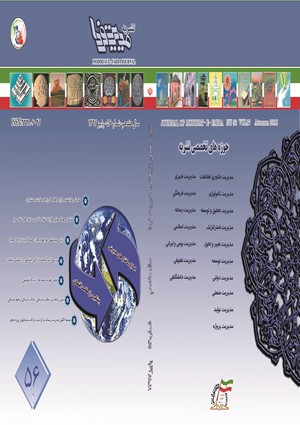The effect of risk and resources on Firm's growth strategies in high tech industries
Subject Areas :
mohsen Parsajam
1
,
2
![]() ,
Bahman Hajipour
3
,
Esmaeil Fadaei Nejad
4
,
Bahman Hajipour
3
,
Esmaeil Fadaei Nejad
4
1 -
2 - مديريت بازرگانی دانشگاه شهيد بهشتی تهران
3 -
4 -
Abstract :
During the last decade there was a well known strategy to support startups and enterprenuers to stabilish firms in high tech industries. despite the position of high-tech industries has been weakened especially in export share. Growth strategies utilized by high-tech firms can improve the position. Growth strategies help firms to increase their market share and sale revenues. Hence, current study aims to designate and validate growth strategies of high-tech firms. Research model has been proposed based on the extended literature, the situation of high-tech industry, and experts' views. Data is gathered by a self-administrated questionnaire and would be analyzed by structural equation modeling using SPSS 18 and LISERL 8.54. Population is managers of high-tech firms in Iran. A convenience sampling approach is employed to collect estimated sample. Data achieved from 451 respondents was analyzed. Results indicated that: 1) growth strategies of high tech firms affect their outputs, 2) resources affect growth strategies of high-tech firms, 3) multiple risks affect the utilization of resources by the high tech firms, and 4) high tech firms provide the needed resources for their growth based on the outcomes in terms of profit and/or attractiveness
منابع حميدي زاده، محمدرضا.، حبيبي، معصومه، حسن بيگي، ابراهيم. (1389). منابع رابطه اي ایجاد ارزش در اجراي راهبرد تنوع از طریق توسعه درونی، چشم انداز مدیریت بازرگانی، شماره 2، پیاپی 35، صفحات. 9-25.
فیض پور، محمدعلی.، محمودی، وحید.، و امامی میبدی، مهدی. (1388). رشد سریع و عوامل موثر بر آن در بنگاه های کوچک تولیدی، پژوهشنامه اقتصادی، سال 9، دوره 4، صفحات. 155-173.
مرتضی نیا، حمید. و فلاح شمس، میرفیض. (1391)، شناخت و اولویت بندي ریسک هاي سرمایه گذاري در پروژه هاي داراي فناوري پیشرفته: مورد مطالعه فناوري نانو، اندیشه مدیریت راهبردي، سال ششم، شماره دوم، شماره پیاپی 12، صفحات 99-120.
واعظ، محمد.، طیبی، سید کمیل. و قنبري، عبدالله. (1386). نقش هزینه هاي تحقیق و توسعه در ارزش افزوده صنایع با فناوري بالا، فصلنامه بررسی هاي اقتصادي، دوره 4، شماره 4، صفحات. 55-72.
Agnihotri, A. (2014). Corporate reputation based theory of choice between organic, hybrid and inorganic growth strategies, Corporate Communications: An International Journal, Vol. 19 No. 3 pp.
247-259 Azofra, S., Olalla, M. G. and Olmo, B.T. (2008). Size, Target Performance and European Bank Mergers and Acquisitions, American Journal of Business, Vol. 23 No. 1, pp. 53-64
Balsam, S., Fernando, G. D. and Tripathy, A. (2011), The impact of firm strategy on performance measures used in executive compensation, Journal of Business Research, Vol. 64 pp. 187-193
Caves, R., and Ghemawat, P. (1992). Identifying Mobility Barriers. Management Journal, Vol. 13 No.1, pp. 1-12
Chathoth, P. K. and Olsen, M. D. (2007), The effect of environment risk, corporate strategy, and capital structure on firm performance: An empirical investigation of restaurant firms, International Journal of Hospitality Management, Vol. 26, pp. 502-516
. Chen,X., Zou,H. and Wang, D. T. (2009). How do new ventures grow? Firm capabilities, growth strategies and performance, Intern. Journal of Research in Marketing, Vol. 26 pp. 294-303
. Criado, M. O. U., Montoro-Sanchez, A., and Mora-Valentın, E. M. (2014). Impact of growth strategy on mode of governance in alliances, International Business Review, Vol. 23 pp. 838-848
. D'Aveni, R. (1995). The New 7S Framework Coping with Hypercompetition. The Academy of Managment Executive Publication, Vol. 9 No. 3, pp. 45-60
. Harrington, B., and Ladge, J. (2009). Present Dynamic and Future Direction of Organizations. Organizational Dynamic, Vol. 38 No.2, pp. 148-157
. Ismail, F., Majid, M. S. and Rahim, R. (2013). Efficiency of Islamic and conventional banks in Malaysia, Journal of Financial Reporting and Accounting, Vol. 11 No. 1, pp. 92-107
. Kylaheiko, K., Jantunen, A., Puumalainen, K., Saarenketo, S. and Tuppura, A. (2011). Innovation and internationalization as growth strategies: The role of technological capabilities and appropriability, International Business Review,Vol. 20 pp. 508-520
. Sharifi, H., Ismail, H. S., Qiu, J.and Najafi Tavani, S. (2013). Supply chain strategy and its impacts on product and market growth strategies: Acasestudy of SMEs, International Journal of Production Economics, Vol. 145 pp. 397-408
. Sheehan, N. T. (2010), A risk-based approach to strategy execution, Journal of Business Strategy, Vol. 31 No. 5 pp. 25- 37
. Sollner, B. (2009). Internal Versus External growth of a company. Wein: Unversity of Wein. Srivastava, R.K. (2012). The role of brand equity on mergers and acquisition in the pharmaceutical industry: When do firms learn from their merger and acquisition experience?, Journal of Strategy and Management, Vol. 5 No. 3, pp.266 – 283
. Weber, Y. and Tarba, S. Y. (2012). Mergers and acquisitions process: the use of corporate culture analysis, Cross Cultural Management: An International Journal, Vol. 19 No. 3 pp. 288 - 303


